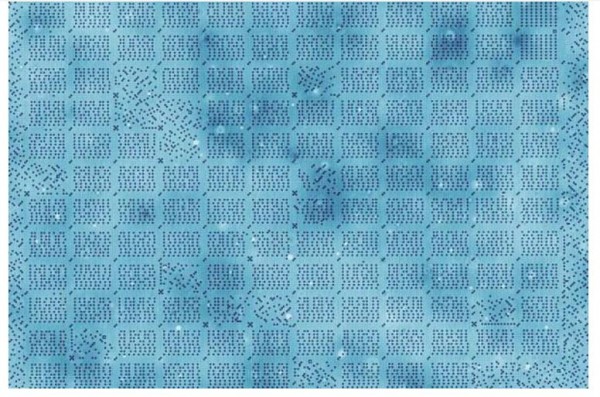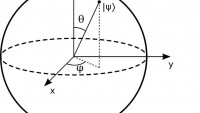World’s Tiniest Hard Disk Stores its Data on Atoms
| Arthur Dominic Villasanta | | Jul 19, 2016 07:03 AM EDT |
(Photo : TU Delft/Ottelab) This illustration shows how the hard disk is organized, with single atoms representing bits of information. The data is organized into blocks of 64 bits.
A prototype atomic hard disk can store every book ever written on its individual atoms that will only be the size a postage stamp when put together.
The stunning device was developed by researchers at Delft University in The Netherlands and features a storage density of 500 terabits into a single square inch. The world's smallest, this hard drive's storage density is 500 times better than the most efficient hard desk on the market.
Like Us on Facebook
The experimental atomic hard drive requires considerable work before it's ready for market, however, but it proves atomic-scale data storage devices are feasible.
To build the device, the team placed chlorine atoms on a copper surface, resulting in a perfect square grid. They then used a scanning tunneling microscope to manipulate atoms to represent binary code, the language used to encode data in computers, said lead researcher Sander Otte, a scientist with the Kavli Institute of Nanoscience at Delft University
"Every bit consists of two positions on a surface of copper atoms, and one chlorine atom that we can slide back and forth between these two positions," said Otte.
"If the chlorine atom is in the top position, there is a hole beneath it -- we call this a 1. If the hole is in the top position and the chlorine atom is therefore on the bottom, then the bit is a 0."
He said because each chlorine in atom is surrounded by other chlorine atoms, they remain stable and stationary. Previous attempts to encode data on the atomic scale relied on loose, unanchored atoms. Data on the hard disk is organized into blocks of 8 bytes or 64 bits.
The technology promises major stability and scalability improvements, but needs considerable improvement before it can be used in real world computers.
Otte noted that in its current form, the memory can operate only in very clean vacuum conditions and at liquid nitrogen temperature, 77 Kelvin, meaning the actual storage of data on an atomic scale is still some way off.
"But through this achievement we have certainly come a big step closer."
©2015 Chinatopix All rights reserved. Do not reproduce without permission
EDITOR'S PICKS
-

Did the Trump administration just announce plans for a trade war with ‘hostile’ China and Russia?
-

US Senate passes Taiwan travel bill slammed by China
-

As Yan Sihong’s family grieves, here are other Chinese students who went missing abroad. Some have never been found
-

Beijing blasts Western critics who ‘smear China’ with the term sharp power
-

China Envoy Seeks to Defuse Tensions With U.S. as a Trade War Brews
-

Singapore's Deputy PM Provides Bitcoin Vote of Confidence Amid China's Blanket Bans
-

China warns investors over risks in overseas virtual currency trading
-

Chinese government most trustworthy: survey
-

Kashima Antlers On Course For Back-To-Back Titles
MOST POPULAR
LATEST NEWS
Zhou Yongkang: China's Former Security Chief Sentenced to Life in Prison

China's former Chief of the Ministry of Public Security, Zhou Yongkang, has been given a life sentence after he was found guilty of abusing his office, bribery and deliberately ... Full Article
TRENDING STORY

China Pork Prices Expected to Stabilize As The Supplies Recover

Elephone P9000 Smartphone is now on Sale on Amazon India

There's a Big Chance Cliffhangers Won't Still Be Resolved When Grey's Anatomy Season 13 Returns

Supreme Court Ruled on Samsung vs Apple Dispute for Patent Infringement

Microsoft Surface Pro 5 Rumors and Release Date: What is the Latest?













